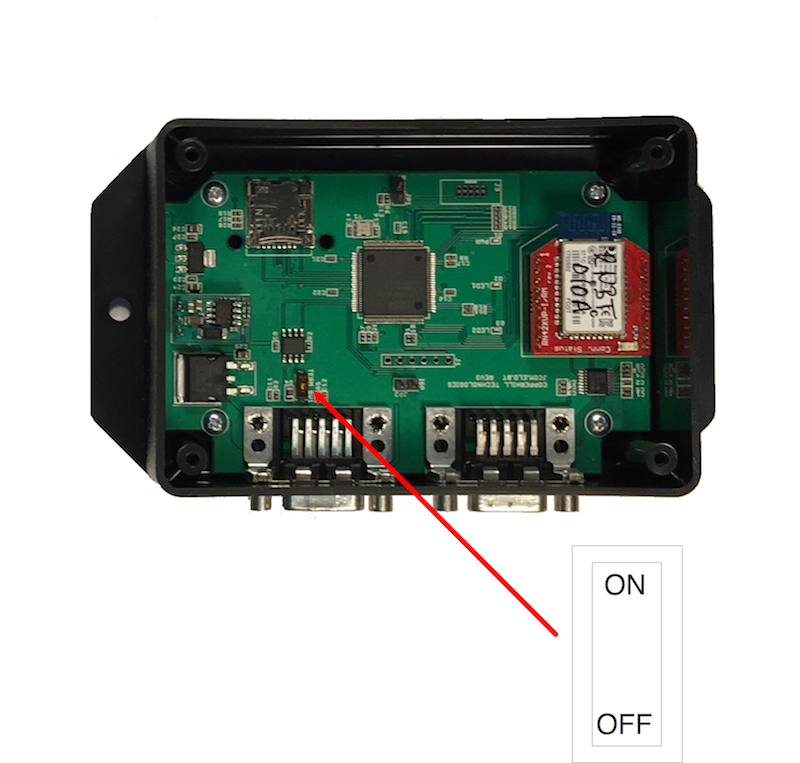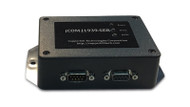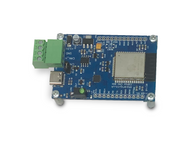SAE J1939 to Bluetooth Gateway
Product Description
Have a look at the replacement unit at:
Option: 9-Pin Deutsch to DB9 Connection Cable
The jCOM.J1939.BT gateway is a high-performance, low-latency, wireless vehicle network adapter for SAE J1939 applications. It allows any host device with a Bluetooth COM port to monitor SAE J1939 data traffic and communicate with the SAE J1939 vehicle network. An SAE J1939 cable, suited for a 9-pin Deutsch connection, can be purchased as indicated above.
The gateway supports the full SAE J1939 protocol according to J1939/81 Network Management (Address Claiming) and J1939/21 Transport Protocol (TP). It is also supported by an extensive programming interface for Windows and Linux/Ubuntu applications, including full C/C++/C# source code for short time-to-market developments.
The strength of the gayteway lies in the fact that the entire SAE J1939 protocol, including all timing requirements, is stored on-chip, thus taking the burden off the main system. The board uses a wireless Bluetooth COM port to communicate with the main system, i.e. all data transfer is handled through a standard COM port access. The communication protocol between the board and the main system is well documented and thus allows a porting to any computer system with a Bluetooth connection. Working source code libraries exist for Windows (C# under Visual Studio 2102/2013), Linux and its derivatives (C++ using Code::Blocks), and Raspberry Pi (C using the standard gcc compiler).
With all its features, the jCOM.J1939.BT gateway allows the simulation of an SAE J1939 ECU (Electronic Control Unit) using embedded solutions such as the Raspberry Pi, BeagleBone, Arduino, Teensy, and others but also PCs running Windows, Linux (incl. Ubuntu, Fedora, etc.), Android, or iOS.
Windows Software
 The communication protocol between the gateway and the host system (PC, Embedded System, Android System, etc.) is well documented, and we provide C source code to read and write CAN data frames.
The communication protocol between the gateway and the host system (PC, Embedded System, Android System, etc.) is well documented, and we provide C source code to read and write CAN data frames.
In addition, the gateway is supported by our jCOM1939 Monitor, an SAE J1939 Monitoring, Analyzer and ECU Simulation software under Windows.
The jCOM1939 Monitor Software is the perfect tool to monitor, analyze, and simulate SAE J1939 data traffic.
The system combines a powerful monitoring software with our jCOM.J1939.BT that functions as an SAE J1939 to Bluetooth gateway.
A comprehensive and easy-to-use, easy-to-understand Windows software displays not only SAE J1939 data traffic; it also allows to scan the network, simulate an ECU (incl. full node address negotiation features), and respond to data request messages.
Features
- ARM Cortex-M3 Processor
- CAN Bus Interface - Fully ISO-11898 Compliant
- RS232 Interface For On-Site Firmware Upload
- Bluetooth module with optional external antenna
- SAE J1939 Protocol Stack
- Extended Temperature Range of -40C to +85C
- Input Power Range of 7 VDC to 36 VDC
- Flame Retardant ABS Enclosure 4.25 x 3.00 x 1.38 in / 107.95 x 76.20 x 35.05 mm
- Environmentally friendly, RoHS compliant
Specifications
- CAN Interface
- CAN Controller integrated in microcontroller
- Fully ISO 11898-compliant
- Supports CAN 2.0A And CAN 2.0B
- Bit rate detection 250/500 kBaud
- Bluetooth Connection
- Fully certified Bluetooth version 2.1
- Backwards-compatible with Bluetooth version 2.0, 1.2, and 1.1
- Low power: 26 µA sleep, 3 mA connected, 30 mA transmit
- Bluetooth SIG certified
- Certifications: FCC, IC, CE
- Two antenna options available: PCB trace and external antenna
- Internal (PCB trace) Antenna: Delivers up to 3 Mbps data rate for distances up to 20 meters (~60 feet)
- External Antenna: Optional upgrade to support distances up to 100 meters (~300 feet)
- SAE J1939 Protocol Stack
- Fully compliant to SAE J1939/21, SAE J1939/81 and SAE J1939/16
- Sending and receiving of messages (PGNs)
- Message filtering
- Request message processing
- BAM and CM transport protocol (TP) processing
- Static and arbitrary address claim
- Automatic baud rate detection (250/500 kbit/sec)
Serial Interfaces

Details of the RS232 and CAN ports are described below.
RS232
The RS232 interface is used for on-site firmware upload. We are working in enhancements of the firmware functionality and we will post updates of the firmware on this product page.

RTS and CTS are not connected. CTS is always held in the ready state.
CAN Port
The CAN port has an on-board 120Ω (0.5W) termination resistor. This termination resistor can be connected or disconnected via an on-board slide switch.

CAN Bus Termination Resistor
The jCOM.J1939.BT gateway comes per default with a 120 Ohm termination resistor activated. To deactivate the resistor, open the enclosure and locate the DIP switch as indicated in the following image.

Windows Firmware Programming
Note: Due to the fact that this is a new product, there are no firmware updates available at this time. Also, you will need a USB-to-RS232 adapter to connect the module to your PC. Any standard adapter will do, but we also recommend using a standard straight RS232 cable, since these adapters use hex screws that collide with the RS232 port.
Firmware updates are initiated through our jCOM1939 Monitor, an SAE J1939 Monitoring, Analyzer and ECU Simulation software under Windows:

The FLASH command button will set the gateway into programming mode, meaning it will cease its regular operation. The only way to resume regular operation is to reset the device per power-cycle (off-on). This feature can be used to load firmware updates into the device. Please check this product page frequently for possible updates.
Connecting Bluetooth to a Windows PC
Connecting Bluetooth to an Android Device
More Resources
- jCOM1939 Monitor, an SAE J1939 Monitoring, Analyzer and ECU Simulation software...
- Communication protocol between the gateway and the host system...
- RN42 low power Bluetooth module (as used in our jCOM.J1939.BT Gateway)...
- Embedded ARM System Serves As SAE J1939 to Bluetooth Gateway...
- How CAN Bus Automatic Baudrate Detection Works And What To Consider When Connecting To A Network...
- ELD Concept: SAE J1939 Data Recording And Display Using Android Or iOS Devices...
- SAE J1939 to Bluetooth Gateway - Android Code (Java) Sample Code...
 Getting Started with Bluetooth Low Energy: Tools and Techniques for Low-Power Networking
Getting Started with Bluetooth Low Energy: Tools and Techniques for Low-Power Networking
With Bluetooth Low Energy (BLE), smart devices are about to become even smarter. This useful guide shows how this impressive wireless technology helps developers create mobile applications that share data with external hardware and how hardware engineers can obtain easy and reliable access to mobile operating systems.
This book renders a reliable, high-level overview of how devices use BLE to communicate with each other. You learn about valuable low-cost tools for developing and testing BLE-enabled mobile apps and embedded firmware and get examples using various development platforms, including iOS and Android for app developers and embedded platforms for product designers and hardware engineers.
- Understand how data is organized and transferred by BLE devices
- Explore BLE’s concepts, key limitations, and network topology
- Dig into the protocol stack to grasp how and why BLE operates
- Learn how BLE devices discover each other and establish secure connections
- Set up the tools and infrastructure for BLE application development
- Get examples for connecting BLE to iPhones, iPads, Android devices, and sensors
- Develop code for a simple device that transmits heart rate data to a mobile device
 Loading... Please wait...
Loading... Please wait...









